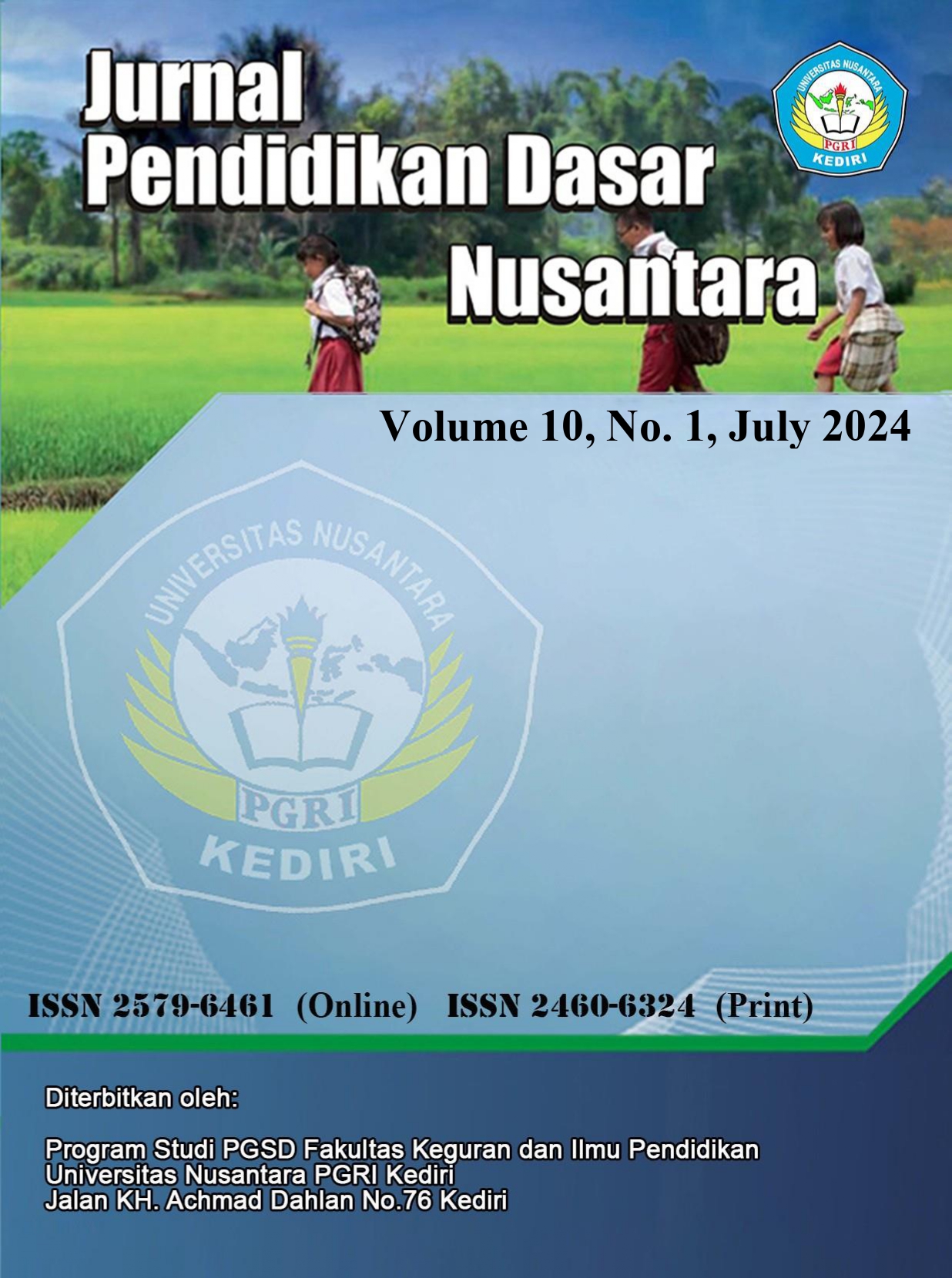Development of Interactive Multimedia Based on Learning Cycle 5E in IPAS Learning for Fourth Grade Elementary School
DOI:
https://doi.org/10.29407/jpdn.v10i1.22897Keywords:
Interactive multimedia, Learning cycle 5E, IPASAbstract
This research aims to develop interactive multimedia based on the 5E learning cycle called MIKBI in science and social learning for grade IV elementary schools. The method in this research uses R&D by adapting the ADDIE development model with stages, namely: 1) Analysis, 2) Design, 3) Development, 4) Implementation, and 5) Evaluation.. The research was carried out at SDN Tanjung Barat 07 with 28 test subjects. Product validity is measured through the assessment of material experts obtained an average score of 92.00% with very decent criteria, media experts gain value 91.76% with very feasible criteria, and linguists gain marks 92.00% with very feasible criteria.Product validity results shows an average value of 91.92% with very feasible criteria. Product testing is carried out in 3 stages, namely one-to-one evaluationan average score of 85.13% with a very decent category, small group evaluation obtained a score of 85.85% in the very feasible category, and the field test evaluation trial obtained a score of 87.08% in the very feasible category so that the average feasibility percentage score obtained at the student trial stage was 86.02% with very feasible criteria. The results of the research show that MIKBI is very suitable for use as science learning media for Indonesian Cultural Wealth material for class IV elementary schools.
Downloads
References
Arifin, K., Sabilu, M., & Sari, W. O. I. (2024). Model Pembelajaran Learning Cycle 5E untuk Meningkatkan Hasil Belajar Kognitif Siswa. AMPIBI: Jurnal Alumni Pendidikan Biologi, 8(4), 314–321.
Budiman, R., Rusdi, R., & Muchlis, E. E. (2019). Penerapan Model Pembelajaran Learning Cycle 5E Untuk Meningkatkan Hasil Belajar Matematika Siswa Kelas VII Smpn 15 Kota Bengkulu. Jurnal Penelitian Pembelajaran Matematika Sekolah (JP2MS), 3(2), 218–227. https://doi.org/10.33369/jp2ms.3.2.218-227
Enstein, J., Rosalina, B. V., & Nahak, R. L. (2021). Pengembangan Media Pembelajaran Game Edukasi Bilangan Pangkat dan Akar menggunakan Genially. Jendela Pendidikan, 02(01), 101–109.
Fadly, W. (2022). Model-Model Pembelajaran untuk Implementasi Kurikulum Merdeka. Bening Pustaka. Model-Model Pembelajaran untuk Implementasi%0AKUrikulum Merdeka
Fatmawati, L., & Dewi, K. P. (2023). Buku Ajar IPS Dasar Beriorientasi Pendidikan Multikultural. K-Media.
Indrawan, Irjus., D. (2020). Media Pembelajaran Berbasis Multimedia. In M. Latif (Ed.), Pena Persada Redaksi : (Vol. 1, Issue 1). Pena Persada Redaksi.
Khaulani, F., Neviyarni, S., & Murni, I. (2020). Fase Dan Tugas Perkembangan Anak Sekolah Dasar. Jurnal Ilmiah Pendidikan Dasar, 7(1), 51–59.
Kustandi, C & Daddy D. (2020). Pengembangan Media Pembelajaran Konsep & Aplikasi Pengembangan Media Pembelajaran bagi Pendidik di Sekolah dan Masyarakat. Jakarta: KENCANA.
Midiyanto, V. F. F., & Hunaifi, A. A. H. (2022). Analisis Kebutuhan Media Pembelajaran untuk Siswa SD pada Materi Pecahan. Seminar Nasional Sains, Kesehatan, Dan Pembelajaran, 2022. https://proceeding.unpkediri.ac.id/index.php/seinkesjar/article/view/3027
Nashrullah. (2022). Pembelajaran Ips (Teori Dan Praktik). CV. EL PUBLISHER.
Pagarra, H., Syawaluddin, A., Krismanto, W., & Sayidiman. (2022). Media Pembelajaran. In Badan Penerbit UNM. Badan Penerbit UNM.
Parni. (2020). Pembelajaran IPS di Sekolah Dasar. Cross-Border: Jurnal Kajian Perbatasan Antarnegara, Diplomasi Dan Hubungan Internasional, 3(2), 96–105.
Putra, L. D., & Afrina, N. (2023). The development of genially-based interactive learning multimedia for elementary school students. Jurnal Fundadikdas (Fundamental Pendidikan Dasar), 6(2), 138–151. https://doi.org/10.12928/fundadikdas.v6i2.8413
Putri, H. D., & Umar, A. (2023). Pengaruh Model Pembelajaran Learning Cycle Terhadap Kemampuan Menulis Teks Persuasi Pada Siswa. Jurnal Riset Rumpun Ilmu Bahasa, 2(2), 168–180. https://doi.org/10.55606/jurribah.v2i2.1699
Rasyid, F. (2022). Metodologi Penelitian Kualitatif dan Kuantitatif Teori, Metode, Dan Praktek. IAIN Kediri Press.
Rezania, V., & Afandi, R. (2020). Pengembangan Pembelajaran IPS SD. In Umsida Press (Vol. 1, Issue 1). UMSIDA Press.
Riduwan and Sunarto, Pengantar statistika untuk penelitian : pendidikan sosial ekonomi komunikasi dan bisnis (Bandung: Alfabeta, 2017).
Sapriyah. (2019). Media Pembelajaran Dalam Proses Belajar Mengajar. Diklat Review : Jurnal Manajemen Pendidikan Dan Pelatihan, 2(1), 470–477. https://doi.org/10.35446/diklatreview.v3i1.349
Saputra, R. Y., & Alexon. (2023). Pengembangan Multimedia Interaktif Berbasis Android Untuk Meningkatkan Kemandirian Belajar. DIADIK: Jurnal Ilmiah Teknologi Pendidikan, 13(1), 48–59.
Septian, D., Cari, & Sarwanto. (2017). Pengembangan Multimedia Interaktif Berbasis Learning Cycle pada Materi Alat Optik Menggunakan Flash dalam Pembelajaran IPA SMP Kelas VIII. 6(1), 45–60.
Triana, K. A., Hendra Cipta, N., & Rokmanah, S. (2023). Pengaruh Kemajuan Teknologi terhadap Perkembangan Pendidikan Karakter Anak Sekolah Dasar. Jurnal Pendidikan Tambusai, 7(3), 24623–24627.
Yusnaldi, E., Aulia, D., Panjaitan, F., Pasaribu, F., Sabina, L., Mustika, N., & Adelia, R. W. (2023). Hakikat Pembelajaran Ilmu Pengetahuan Sosial. Jurnal Pendidikan Tambusai, 7(3), 32175–32181.
Downloads
Published
Issue
Section
License
Authors who publish with this journal agree to the following terms:
- Copyright on any article is retained by the author(s).
- The author grants the journal, the right of first publication with the work simultaneously licensed under a Creative Commons Attribution License that allows others to share the work with an acknowledgment of the work’s authorship and initial publication in this journal.
- Authors are able to enter into separate, additional contractual arrangements for the non-exclusive distribution of the journal’s published version of the work (e.g., post it to an institutional repository or publish it in a book), with an acknowledgment of its initial publication in this journal.
- Authors are permitted and encouraged to post their work online (e.g., in institutional repositories or on their website) prior to and during the submission process, as it can lead to productive exchanges, as well as earlier and greater citation of published work.
- The article and any associated published material is distributed under the Creative Commons Attribution-ShareAlike 4.0 International License

































